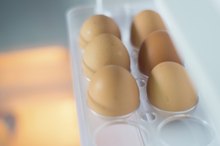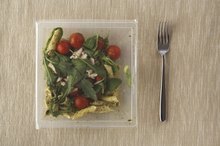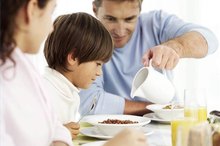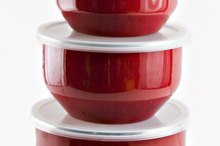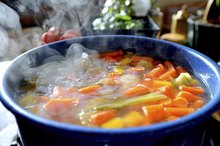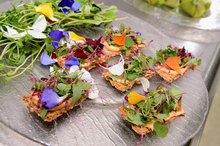Side Effects of Eating Thawed Then Refrozen Food
Frozen food remains safe to eat for months in the freezer, but once food thaws, the clock that measures its edible phase begins to tick. Even if you've thawed food safely in the microwave, refrigerator or a cold water bath, refreezing it will degrade its quality. If you've thawed exposed food at room temperature -- an unsafe practice -- your food could become a home for numerous pathogens that cause food-borne illness.
Freezer Burn
Freezer burn occurs when moisture leaves frozen food, leaving desiccated patches where the food turns leathery or mealy. Any food can develop freezer burn when it stays in your freezer too long, but it's likelier to happen when you refreeze food after thawing it. Thawing allows ice to melt back into water; when you freeze the food again, that water turns into larger ice crystals that tear food apart from the inside, exposing more of the damaged cells to the arid atmosphere of your freezer and leaving it more susceptible to freezer burn.
Poor Food Texture
Bacteria That Grow in the Refrigerator
Learn More
Large ice crystals degrade the textures of food, and refreezing a thawed product creates larger crystals. The characteristic crunch of a bell pepper and the juiciness of a steak are both the result of the foods' cellular structures. When these cells rip apart under the force of expanding ice crystals, the food turns into mush. If you want to maintain the integrity of an ingredient's texture, use it shortly after it's thawed or cook it from a fresh state.
- Large ice crystals degrade the textures of food, and refreezing a thawed product creates larger crystals.
- If you want to maintain the integrity of an ingredient's texture, use it shortly after it's thawed or cook it from a fresh state.
Increased Risk of Bacterial Contamination
Depending on your thawing method, refreezing thawed food could create an opportunity for microbial contamination. While safe thawing methods that take place outside of what the U.S. Department of Agriculture calls the "danger zone" -- between 40 and 140 degrees Fahrenheit -- don't generally give bacterial contamination a chance to happen, there's always a possibility that a portion of the food could reach that danger zone despite your care. The window for contamination may be small, but microbes will take advantage of even a small opportunity. When you later freeze the thawed food, you also freeze the microorganisms within it, giving them a chance to grow unchecked the next time you thaw the food.
- Depending on your thawing method, refreezing thawed food could create an opportunity for microbial contamination.
- When you later freeze the thawed food, you also freeze the microorganisms within it, giving them a chance to grow unchecked the next time you thaw the food.
Safe Food Handling Practices
What Is a Ready-to-Eat Food?
Learn More
The U.S. Department of Agriculture's guidelines on food safety suggest that foods thawed in the refrigerator are safe to refreeze. However, they note that foods thawed in the microwave or in a cold water bath must be cooked before you freeze them to avoid the possibility of allowing microbes to flourish. These three methods -- microwaving, gradual thawing in the refrigerator and soaking in a cold water bath -- are the only three methods that the USDA recommends for thawing food. They suggest that cooking without thawing is another possibility, depending on your cooking method.
- The U.S. Department of Agriculture's guidelines on food safety suggest that foods thawed in the refrigerator are safe to refreeze.
- These three methods -- microwaving, gradual thawing in the refrigerator and soaking in a cold water bath -- are the only three methods that the USDA recommends for thawing food.
Related Articles
References
Writer Bio
Lauren Whitney covers science, health, fitness, fashion, food and weight loss. She has been writing professionally since 2009 and teaches hatha yoga in a home studio. Whitney holds bachelor's degrees in English and biology from the University of New Orleans.
